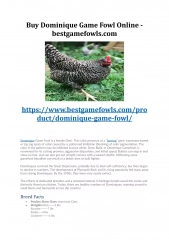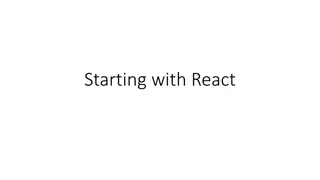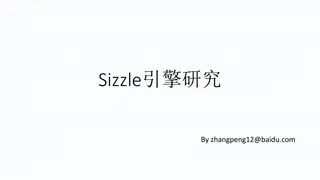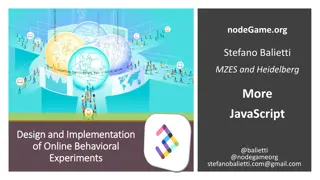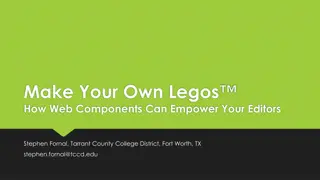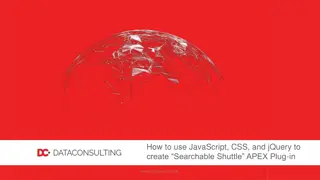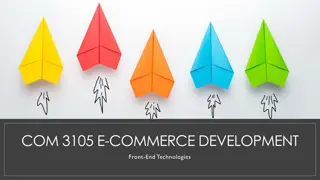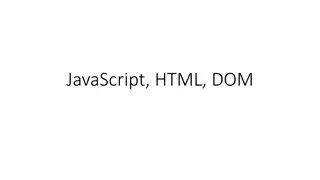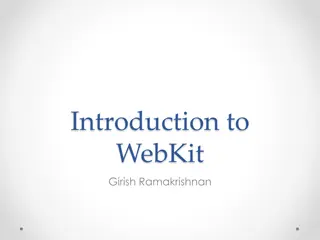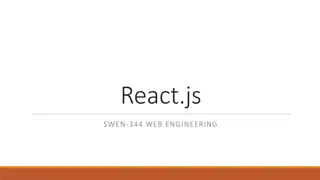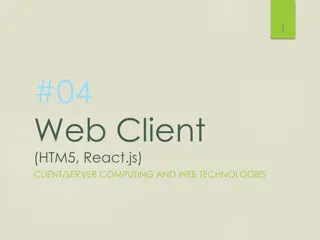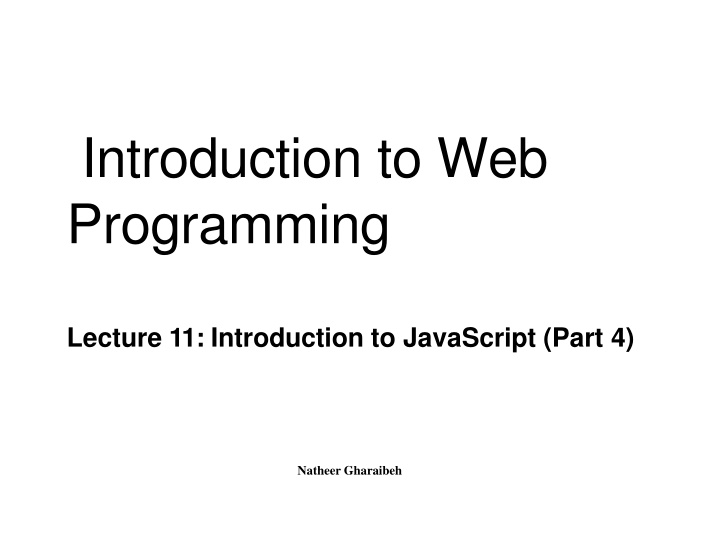
JavaScript Event-Driven Programming Overview
Explore the concepts of event-driven programming in JavaScript and how it influences the flow of programs based on user actions, sensor outputs, and messages from other sources. Learn about handling HTML events like onchange and onclick to enhance user interactions and perform actions in response to them.
Download Presentation

Please find below an Image/Link to download the presentation.
The content on the website is provided AS IS for your information and personal use only. It may not be sold, licensed, or shared on other websites without obtaining consent from the author. If you encounter any issues during the download, it is possible that the publisher has removed the file from their server.
You are allowed to download the files provided on this website for personal or commercial use, subject to the condition that they are used lawfully. All files are the property of their respective owners.
The content on the website is provided AS IS for your information and personal use only. It may not be sold, licensed, or shared on other websites without obtaining consent from the author.
E N D
Presentation Transcript
Introduction to Web Programming Lecture 11: Introduction to JavaScript (Part 4) Natheer Gharaibeh
Outlines of todays lecture Events Assigning events using DOM Dom nodes Browser Object Model (BOM) 2
concepts In programming is a programming paradigm in which the flow of the program is determined by events such as user actions (mouse clicks, key presses), sensor outputs, or messages from other programs or threads. Event-driven programming is the dominant paradigm used in graphical user interfaces and other applications (e.g., JavaScript web applications) that are centered on performing certain actions in response to user input. This is also true of programming for device drivers (e.g., P in USB device driver stacks[1]). computer programming, event-driven
HTML events HTML events are "things" that happen to HTML elements. An HTML event can be something the browser does, or something a user does. Here are some examples of HTML events: An HTML web page has finished loading An HTML input field was changed An HTML button was clicked Often, when events happen, you may want to do something. JavaScript lets you execute code when events are detected. HTML allows event handler attributes, with JavaScript code, to be added to HTML elements.
Event Attributes Attribute onchange The event occurs when... The content of a field changes onclick Mouse clicks an object ondblclick Mouse double6clicks an object oerror onerror An error occurs when loading a document or an image onload A page or image is finishedloading onmouseout The mouse is moved off an element onmouseover The mouse is moved over an element 5
onchange Event The onchange event occurs when the content of a field changes. often used in combination with validation of input fields <html> <head> <script type="text/javascript"> function upperCase(x) { var y=document.getElementById(x).value; document.getElementById(x).value=y.toUpperCase(); } </script> </head> <body> Enter your name: <input type="text" id="fname" onchange= "upperCase(this.id)" /> </body> </html> 6
onclick Event The onclick event occurs when an object gets clicked. <html> <body> Field1: <input type="text" id="field1" value="Hello World!" /> <br /> Field2: <input type="text" id="field2" /> <br /><br /> Click the button to copy the content of Field1 to Field2. <br /> <button onclick="document.getElementById('field2').value=document.getE lementById('field1').value">Copy Text</button> </body> </html> 7
ondbclick Event The ondblclick event occurs when an object gets double-clicked. <html> <body> Field1: <input type="text" id="field1" value="Hello World!" /> <br/> Field2: <input type="text" id="field2" /> <br /><br /> Double Click the button to copy the content of Field1 to Field2. <br/> <button ondblclick="document.getElementById('field2').value=document.get ElementById('field1').value">Copy Text</button> </body> </html> 8
onerror Event The onerror event is triggered when an error occurs with an element. <html> <body> <img src="image.gif" onerror="alert('The image could not be loaded.')" /> <p>In this example we refer to an image that does not exist, therefore we will get the alert box.</p> </body> </html> 9
onload Event The onload event occurs immediately after a page or an image is loaded. <html> <head> <script type="text/javascript"> function load() { alert("Page is loaded"); } </script> </head> <body onload="load()"> <h1>Hello World!</h1> </body> </html> 10
onmouseover and onmouseout Events The onmouseover event occurs when the mouse pointer moves over a specified object. The onmouseout event occurs when the mouse pointer moves away from a specified object. <html> <body> <img src="image_w3default.gif" name="mousetest" onMouseOver="document.images['mousetest'].src='image_w3def ault2.gif'" onMouseOut="document.images['mousetest'].src='image_w3defa ult.gif'" width="234" height="91" /> </body> </html> 11
Assigning Events Using DOM The HTML DOM allows you to assign events to HTML elementsusing JavaScript: Assign an onclick event to a button element: <script> document.getElementById("myBtn").onclick = function(){ displayDate() }; </script> 12
Checkbox checked attribute <html> <head> <script type="text/javascript"> function check() { document.getElementById("check1").checked=true;} function uncheck() { document.getElementById("check1").checked=false;} </script> </head> <body> <form> <input type="checkbox" id="check1" />Do you like summer? <input type="button" value="Check Checkbox" onclick="check()" / > <input type="button" value="Uncheck Checkbox" onclick="uncheck()" / > </form> </body> </html> 13
Radio Button value and checked attributes <html> <head> <script type="text/javascript"> functionshowFun() { var x=""; if(document.getElementById("r1").checked==true) x=document.getElementById("r1").value; else if(document.getElementById("r2").checked==true) x=document.getElementById("r2").value; alert(x); } </script> </head> <body> Gender:<br/> <input type="radio" name="gender" value="Male" id="r1" /> Male <br/> <input type="radio" name="gender" value="Female" id="r2" /> Female <br/> <input type="button" value="show gender" onclick="showFun()"/> </body> </html> 12
Select selectedIndex Property <html><head> <scripttype="text/javascript"> function displayResult() { vary=document.getElementById("car").options; varx=document.getElementById("car").selectedIndex; alert("x= " + x + " y[" + x + "]= " + y[x].value); } </script> </head> <body> Select your Car:<br/> <selectid="car"> <option value ="Kia"> KIA </option> <option value ="bmw"> BMW </option> <option value ="jaguar"> JAGUAR </option> <option value ="golf"> GOLF </option> </select> <input type="button" value="showCar" onclick="displayResult()"> </body></html> 15
Demo! 16
DOM Nodes According to the W3C HTML DOM standard, everything in an HTML documentis a node: The entire document is a document node Every HTML element is an element node The text inside HTML elements are text nodes Every HTML attribute is an attribute node All comments are comment nodes 17
Navigating Between Nodes You can use the following node properties to navigate between nodes with JavaScript: parentNode childNodes[nodenumber] firstChild lastChild nextSibling previousSibling 18
Node PropertiesExamples In addition to the innerHTML property, you can also use the childNodes and nodeValue properties to get the content of an element. <html> <body> <h1 id="intro">My First Page</h1> <p id="demo">Hello!</p> <script> var myText = document.getElementById("intro").childNodes[0].nodeValue; document.getElementById("demo").innerHTML = myText; </script> </body> </html> 19
Node PropertiesExamples Using the firstChild property is the same as using childNodes[0]: <html> <body> <h1 id="intro">My First Page</h1> <p id="demo">Hello World!</p> <script> myText = document.getElementById("intro").firstChild.nodeValue; document.getElementById("demo").innerHTML = myText; </script> </body> </html> 20
The Browser Object Model (BOM) The Browser Object Model (BOM) is a collection of objects that give you access to the browser and the computer screen. These objects are accessible through the global object window The window object is supported by all browsers. It represents the browser's window. There's a window object for every frame, iframe, pop up, or browser tab. All global JavaScript objects, functions, and variables automatically become members of the window object. 21
The setTimeout() Method Syntax window.setTimeout("javascript function", milliseconds); The window.setTimeout() method can be written without the window prefix. The setTimeout() method will wait the specified number of milliseconds, and then execute the specified function. The first parameter of setTimeout() should be a function. The second parameter indicates how many milliseconds, from now, you want to execute the first parameter. Example Click a button. Wait 3 seconds. The page will alert "Hello": <button onclick = "setTimeout(function(){alert('Hello')}, 3000)">Try it</button> 22
The setInterval () Method The setInterval() method will wait a specified number of milliseconds, and then execute a specified function, and it will continue to execute the function, once at every given time-interval. Syntax window.setInterval("javascript function", milliseconds); The window.setInterval() method can be written withoutthe window prefix. The first parameter of setInterval() should be a function. The second parameter indicates the length of thetime- intervals between each execution. Note: There are 1000 milliseconds in onesecond. Example Alert "hello" every 3 seconds: setInterval(function () {alert("Hello")}, 3000); 23
References www.w3schools.com Stefanov, S. (2013). Object-Oriented JavaScript. Packt Publishing Ltd. Deitel & Deitel (2011). Internet and World Wide Web How to Program, 5th Edition, Harvey & Paul Deitel &Associates. 24

